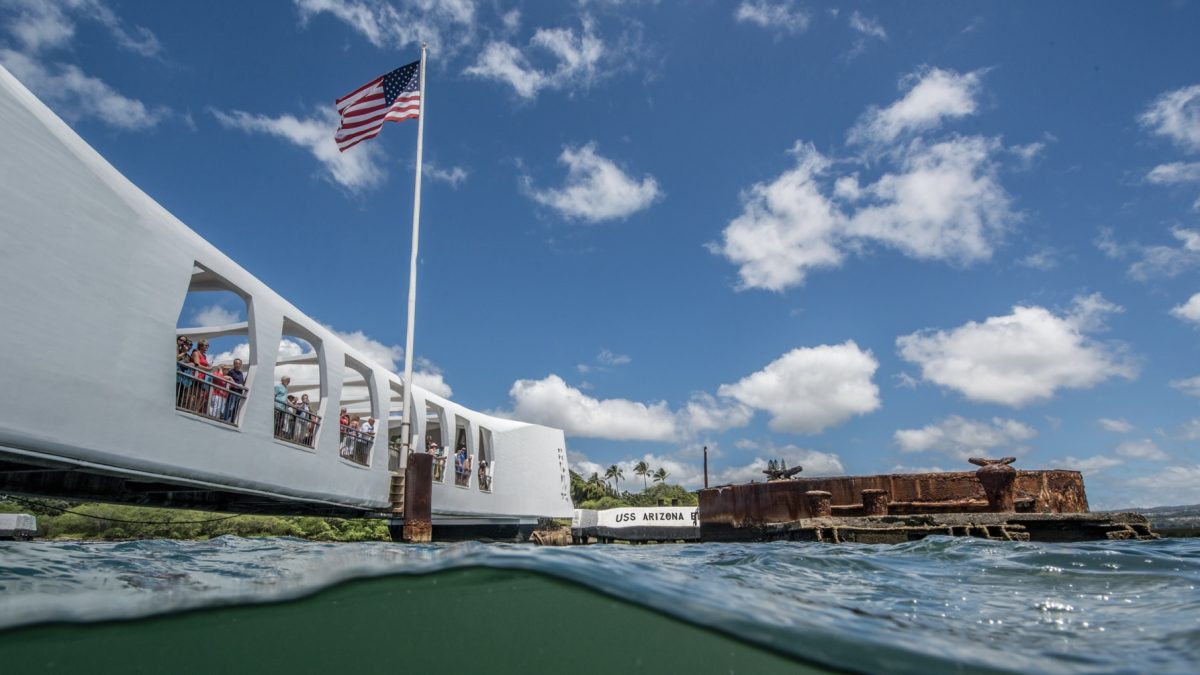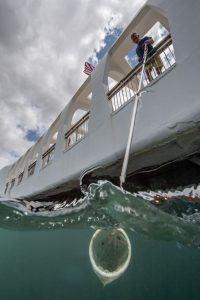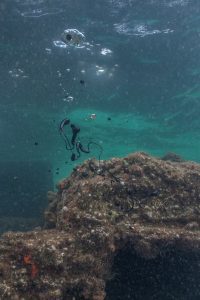USS Arizona provides blueprint for addressing oil leakage at thousands of WWII shipwrecks
 The Flag of the United States of America over the site of the USS Arizona Memorial. The findings underscore the USS Arizona’s dual role as a solemn memorial and a “living laboratory.” (Photo by Brett Seymour, NPS Submerged Resources Center)
The Flag of the United States of America over the site of the USS Arizona Memorial. The findings underscore the USS Arizona’s dual role as a solemn memorial and a “living laboratory.” (Photo by Brett Seymour, NPS Submerged Resources Center) October 2, 2025
The findings underscore the USS Arizona’s dual role as a solemn memorial and a “living laboratory.”
Photos available for use with credit can be found here.
Woods Hole, Mass. (October 2, 2025) — A new study published in Marine Pollution Bulletin shows that oil is still seeping from the wreck of the USS Arizona, more than 80 years after its sinking at Pearl Harbor. The study focuses on samples collected by the National Park Service in 2016 and 2018.
Researchers, led by the University of Houston and Woods Hole Oceanographic Institution (WHOI), analyzed oil samples collected from multiple leak points on the sunken battleship, using advanced molecular fingerprinting techniques. The results confirm the oil is a heavy fuel oil refined from California crude, consistent with U.S. Navy fueling practices in the early 1940s. Despite being underwater for decades, the oil retains high concentrations of polycyclic aromatic hydrocarbons (PAHs), compounds known for their persistence and potential toxicity.

WHOI Marine Chemist Chris Reddy collects oil samples from the USS Arizona Memorial in 2018. (Photo by Brett Seymour, NPS Submerged Resources Center)
“One of the biggest challenges in responding to oil spills is understanding the specific makeup of the oil. At this site, the oil is not leaking at a highly concerning rate, and while it does contain polycyclic aromatic hydrocarbons (PAHs), not all of them are highly toxic,” said WHOI marine chemist and senior author of the study, Chris Reddy. “This work offers valuable insights that strengthen preparedness and planning for future operations at other shipwrecks.”
Researchers also found that the chemical composition of the oil varies depending on the leak location, reflecting differing degrees of natural “weathering” processes, including microbial biodegradation and dissolution. While lighter compounds are gradually breaking down, key petroleum biomarkers remain intact, allowing scientists to trace the oil’s source and behavior over time.
Although the oil seeping from the USS Arizona comes from the same shipping fuel, it changes chemically before it escapes,” said Jagoš Radović, University of Houston research associate professor and lead author of the study. “As it moves through the maze of wreckage, it encounters varying oxygen levels, water flow, and microbial activity, shaping the oil’s chemistry and giving each leak a unique fingerprint.”
The findings underscore the USS Arizona’s dual role as a solemn war grave and a “living laboratory” for understanding the long-term fate of petroleum trapped in shipwrecks. With an estimated 600,000 gallons of oil still on board, the research highlights the importance of ongoing monitoring and preparedness at the site.

Oil spills out of the USS Arizona in Hawaii. With an estimated 600,000 gallons of oil still on board, the research highlights the importance of ongoing monitoring and preparedness at the site. (Photo by Brett Seymour, NPS Submerged Resources Center)
“As one of America’s most hallowed war graves and the site of tragedy and sacrifice at the outset of a global conflict for our country, the site demands the best and most considered science we can muster,” said Dr. David Conlin, a marine archeologist with the National Park Service. “The work we have completed is groundbreaking in its implications and also its respectful, non-intrusive approach to data gathering. I am proud and humbled to have been a part of this incredible scientific team.”
More broadly, the study has global significance. Thousands of World War II-era wrecks, containing millions of gallons of unrecovered fuel, rest on ocean floors worldwide, many in nearshore environments. The USS Arizona offers a unique insight into how oil behaves over decades in low-oxygen, submerged conditions, informing modern spill response strategies and environmental risk assessments.
“When deciding whether to remove oil from a shipwreck, we weigh the risk of a potential spill against the danger of disturbing the site itself,” Reddy continued. “Factors like the amount of oil remaining, the rate of leakage, the local ecosystem’s sensitivity, and the cultural or historical value of the wreck all play a role. Sometimes the best choice is careful monitoring rather than intervention.”
The research was led by a team from the University of Houston, Woods Hole Oceanographic Institution, the U.S. Coast Guard Academy, the National Park Service, Western Washington University, UC Santa Barbara, Northeastern University, and Appalachian State University.
###
About Woods Hole Oceanographic Institution
Woods Hole Oceanographic Institution (WHOI) is a private, non-profit organization on Cape Cod, Massachusetts, dedicated to marine research, engineering, and higher education. Established in 1930, its mission is to understand the ocean and its interactions with the Earth as a whole, and to communicate an understanding of the ocean’s role in the changing global environment. WHOI’s pioneering discoveries stem from an ideal combination of science and engineering—one that has made it one of the most trusted and technically advanced leaders in fundamental and applied ocean research and exploration anywhere. WHOI is known for its multidisciplinary approach, superior ship operations, and unparalleled deep-sea robotics capabilities. We play a leading role in ocean observation and operate the most extensive suite of ocean data-gathering platforms in the world. Top scientists, engineers, and students collaborate on more than 800 concurrent projects worldwide—both above and below the waves—pushing the boundaries of knowledge to inform people and policies for a healthier planet. Learn more at whoi.edu.
